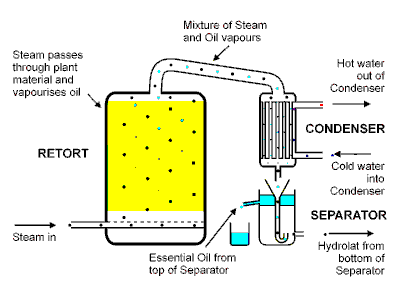Hydrosol Information
Home / Hydrosol Information
Understanding Hydrosols
Hydrosols are the secondary products of the essential oil distillation process, which themselves contain the emulsified oil.
These watery solutions, or hydrosols, are a much underrated result of the distillation process. For many years, due to a lack of understanding of their properties and uses, they were often simply disposed of.
Hydrosols are not simply essential oils added to water, as often wrongly assumed, and they cannot be manufactured synthetically. They have their own distinct composition and properties as well as many of the properties of the oil itself.
This uniqueness means Hydrosols have varied uses. Unlike their essential oil counterparts, they can be applied directly to the skin - making them particularly ideal for use with high risk groups such as babies, pregnant women, animals or those with delicate immune systems.
Distillation & Creation

During distillation, steam is passed through the plant & flower, extracting as it passes the volatile compunds contained within the flower. This steam is then passed over cold surfaces, or condensers, converting the steam back into liquid. As the steam cools and converts to water, the essential oil naturally separates itself and stays on the surface.
However, the hydrophillic (water loving) compounds inherent in the plant, remain in the water, thus creating the hydrosol (or hydrolat). Once all the oil and hydrolat has collected, we are easily able to separate the two.
Sterility & Preservatives
One of the most important things to consider when purchasing hydrosols is how & where they were produced. One of the most common issues with hydrosols is the fact that, if not stored or produced correctly, they can be an ideal solution for bacteria to thrive.
Contamination of this kind arises from the atmosphere, and the particles getting into the solution as it is collected during the distillation process. Due to the nature of the steaming process, Hydrosols are fully sterile when first created, and as such, the use of air tight equipement and storage vessels prevents atmospheric contamination.
At Essencia Oils, we use only sterile stainless steel equipment & tanks, which flow directly into sealed containers, therefore minimising the reduce of contamination considerably.
The final product is then stored in a cool, dark barn ensuring the deletorious effects of fluctuating light & temperature are kept to an absolute minimum.
Further issues come into play, when the majority of manufacturers chose to add preservatives or alcohol to the hydrosol to extend its shelf life, andfurther prevent bacteria from multiplying. This diffuses the purity of the hydrosol, and damages its quality. As our hydrosols are distilled in sealed, sterile containers, we feel no need to add such alcohols. Our hydrosols are put fresh on our shelves, and replaced by the new seasons harvest well within their natural twelve month shelf life, thus leaving no need for preservatives.
If you, as the end user, wish to add alcohol to extend the shelf life further, this is not necessarily a bad thing, but please be aware, it requires around 30% alcohol to make a real difference! Consider this, and how it will effect the quality of your hydrosol before you do!
If you, as the end user, wish to add alcohol to extend the shelf life further, this is not necessarily a bad thing, but please be aware, it requires around 30% alcohol to make a real difference! Consider this, and how it will effect the quality of your hydrosol before you do!
In our experience, if stored and cared for well, hydrosols will rarely spoil. Here is what we suggest:
1. Store in the fridge
2. 2. When handling or decanting ensure utensils are sterile
3. 3. Keep out of sunlight



